
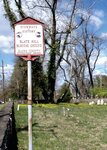
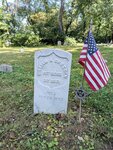
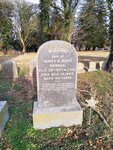

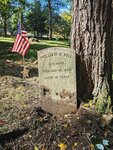
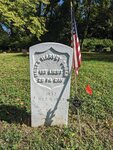
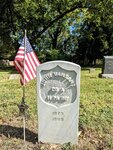

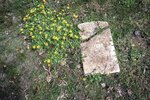


Thousands of Civil War veterans are buried in cemeteries near the well-known battlefields where they perished. Headstones typically identify the date of death, rank and unit affiliation. Many other unidentified soldiers were interred in mass graves. Battlefield preservation and research efforts continue to discover remains thought lost to changing landscapes.
But thousands more made the transition to postbellum civilian life. They reestablished themselves in pre-war occupations or forged new ones. Most left the armed services for good to become merchants, factory workers, farmers, laborers and ministers.
Many lived and died in relative anonymity, their wartime exploits largely forgotten.
For enlisted veterans of the United States Colored Troops (USCT), the postwar life involved the new experience of freedom and recognition of their honorable service.
Slate Hill Burial Ground in Lower Makefield is said to be the oldest cemetery in Bucks County, with interments dating to the 1690s. The oldest tombstone has 1698 inscribed on it and the last internment occurred in 1918.
It has three sections — the original granted by Thomas Janney in 1690, one granted by Abel Janney in 1721, and the last public section granted by Joshua Anderson in 1788.
The main section holds the remains of the Quaker founders of the town of Yardley. Initially, Quakers buried their own on top of each other without tombstones or any other type of grave markers. While they eventually embraced markers in the 1800s, the remaining 275 headstones fall well short of memorializing the thousands buried there.
Slate Hill’s public section was unique in that it permitted the interment of free Black people.
Quiet and isolated, Slate Hill hosts the graves of 20 men who served the Union. The public section is the final resting place of eight USCT veterans and one U.S. Navy veteran.
The public section, the coolest due to a canopy of shade-providing trees, is separated by a brick wall from the main plot.
In addition to the inscriptions on the stones indicating rank and regiment, Grand Army of the Republic markers also help indicate the graves of the Union veterans. GAR and its successor, the Sons of Union Veterans of the Civil War (SUVCW), cared for the graves of its veterans, placing grave-site GAR markers as well as flags. Like Union infantry regiments, the cemetery was segregated.
Among the undergrowth and meandering path in the public section was a broken headstone accompanied by a faded Old Glory and a GAR marker, the final resting place of Samuel Harmon, who died on July 25, 1903, at the age of 59. Harmon’s headstone was a brownstone, a type of sandstone marker which ranges in color from a dark blond to dark brown, depending on the minerals. As sedimentary markers, brownstones tend to deteriorate over time.
Harmon served in the 24th regiment of the USCT. The 24th mustered on Feb. 17, 1865 and trained at Camp William Penn in present day Philadelphia. From 1863 until the end of the war, approximately 11,000 free Black men and escaped slaves trained at Camp William Penn, including 8,612 from Pennsylvania, the most recruited during the war from any northern state.
Harmon served as a drummer in Company F of the 24th USCT. Although his stone indicates that he died at age 59, his enlistment papers indicate that he was 16 when he joined the Army.
The 24th PA was active between May and September 1865, after most combat had ceased. The regiment mostly served garrison duty, which included guarding Confederate prisoners, preserving order, and distributing supplies in Camp Casey, VA, Point Lookout, MD, and Roanoke, VA. During his service, Harmon was promoted to corporal. His regiment mustered out on Oct. 1, 1865.
After the war, Harmon married and had children. He worked in nearby Trenton, NJ and died tragically on July 25, 1903 due to a fall from a trolley car as he returned from work.
Brothers William (died Dec. 31, 1901, age 69) and Torbut (died July 15, 1897, age 59) Ganges served in Company H of the 32nd Regiment of the USCT. The 32nd fought at the Battle of Honey Hill (alongside the famed 54th Massachusetts) on Nov. 30, 1864 during Sherman’s March to the Sea and later served as an occupation force in Charleston, SC. The 32nd lost 150 men during the war with two officers and 35 enlisted men killed or mortally wounded and 113 enlisted deaths from disease.
There are five other USCT graves, including those belonging to Jefferson Mosley, George Congo, and Thomas Miller.
Mosley served in Company E of the 25th USCT, which operated chiefly as a garrison force in the Department of the Gulf with posts at New Orleans, La. and Fort Pickens, Fla. Mosley died Feb. 2, 1908.
George Congo served with Company A of the 22nd USCT, serving through the Siege of Peterburg and at the battles of Second Deep Bottom, Second Fair Oaks and Chaffin’s Farm, all in Virginia. Congo died Feb. 22, 1901, at age 55.
Like Samuel Harmon, Thomas Miller also served in Company F of the 24th USCT. Miller died April 18, 1884.
One of the more challenging graves to find is that of William H. Hill, whose brownstone rested at a 45 degree angle due to the protuberance of tree roots and was disintegrating. Hill was the only veteran buried in Slate Hill to serve in the U.S. Navy during the Civil War.
Hill served as a landsman performing menial tasks aboard the Harvest Moon, a side-wheel steamer in the South Atlantic Blockading Squadron. The Harvest Moon was the flagship of Rear Admiral John A. Dahlgren. Commissioned on Feb. 12, 1864, the ship struck a mine on March 1, 1865 in Winyah Bay, S.C. near the port town of Georgetown, sinking in less than three minutes. Dahlgren ordered Hill into the cold water to retrieve his papers and personal effects. Hill later claimed that he contracted rheumatism from this action in his postwar pension application. He died July 16, 1904 at 76 years.
In the main section, lies 1st Lt. Moses Harvey Suber, Company I, 20th Regiment PA Cavalry. Suber, aged 30, and 150 other local men responded to Pa. Gov. Andrew Curtain’s Emergency and State Militia Act and joined the Union war effort on July 4, 1863. The act called for a supplemental army corps of infantry, cavalry and artillery to help defend the Pennsylvania against the invading Army of Northern Virginia.
Suber enlisted as a private but was promoted. His unit engaged Maj. General Jubal Early’s division during the Confederate retreat from Gettysburg. Suber was wounded by a sharpshooter and later died in Philadelphia on Oct. 3, 1863. He is the only Civil War soldier buried at Slate Hill who died of wounds received in battle.
In one group in the main section are some of the largest and best-preserved original headstones in Slate Hill. These belong to the Duncan family, including a large headstone commemorating the life of William Duncan, Company K, 35th Regiment, NJ Volunteers. The 35th served most notably with the Army of the Tennessee during the Atlanta Campaign, March to the Sea, and the Carolinas Campaign through Gen. Joseph E. Johnston’s surrender at Bennett Place in North Carolina on April 26, 1865. Duncan was 52 when he died on Aug. 12, 1887.
Duncan’s army service remained a seminal memory to his family. His headstone bears the following inscription as a tribute to his service, “Green mounds are thickening where sleep the true and brave. And over one a bird keeps watch. It is our soldier’s grave.”
Several veterans’ headstones, especially the brownstones, were impacted by more than 100 years of extreme Mid-Atlantic weather. The markers for Harmon, Hill, and Suber were in seriously decayed condition to the point where they were near illegible and crumbling. Their markers, plus the markers of other Union veterans that were never issued, stolen or crumbled, were replaced with new white granite markers in September 2020.
The Lower Makefield Historical Commission and local Boy Scouts were instrumental in obtaining the new stones.
William Brogden served with William and Torbut Ganges in Company H of the 32nd USCT as Company H’s 1st Sergeant, a position of great responsibility and esteem, critical to a unit’s performance and maintenance of drill and discipline.
Postwar, Brogden continued his wartime shepherding by becoming a local minister. He died on Feb. 25, 1899, age 74.
All three men settled in the Bucks County area after the war, and it’s likely the Ganges brothers reminisced with their 1st Sergeant long after their service ended together. Their graves lie three abreast in the public section.
Private Lewis Frame served in Company G of the 25th USCT, the same unit as Jefferson Mosley; their graves are adjacent.
Frame enlisted in February 1864 at age 26 and served as a bugler and cook and was honorably discharged.
He died on April 22, 1908 at the age of 70.
Back in the main section, the grave of Private George Worthington of 174th Pennsylvania Regiment, Company G also received a new stone in September 2020. Worthington was drafted with his militia unit and cobbled into the 174th PA in November 1862. The unit served at Suffolk, VA and in Beaufort and Hilton Head, SC. The 174th saw no action but still lost 13 men to disease.
Worthington mustered out in August 1863 and died in 1903.
Private John S. Vansant served in Company A of the 11th PA Infantry Regiment. He enlisted in September 1861, aged 21, in the unit that would become known as “The Bloody Eleventh,” which fought at Cedar Mountain, Thorofare Gap, Second Manassas, South Mountain, Antietam, Fredericksburg, Chancellorsville, Gettysburg, Mine Run, Wilderness, Spotsylvania, Cold Harbor, Petersburg, Five Forks, and Appomattox.
In keeping with the unit’s moniker, Vansant was wounded four times and was later placed in the Invalid Reserve to guard Confederate prisoners. Vansant was honorably discharged on July 7, 1865.
Postwar, he married, had a son, and died in 1889 at age 60.
Slate Hill Burial Ground is easily overlooked by cars traveling on the adjacent road. The placid scenery and Quaker roots offer quiet balance to the terrifying experiences many of these men witnessed during the war.
Whether they served in garrison details or in combat, each of these men served their country with honor.
The Knowles-Davis American Legion Post 317 (located across the street from Slate Hill Burial Ground) and the Veterans of Foreign Wars Post 6393 continue to recognize these heroes next door each Memorial Day by placing new flags, delivering honorary salutes, and playing Taps.
Join our readers whose generous donations are making it possible for you to read our news coverage. Help keep local journalism alive and our community strong. Donate today.